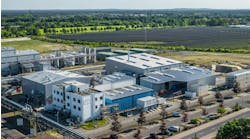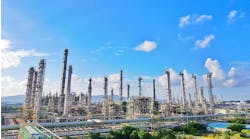An ammonia fertilizer plant in Oklahoma evaluated its steam system and found important energy-savings opportunities that could reduce energy use, costs, emissions and improve productivity. Here is their success story.
[pullquote]
The highly integrated manufacturing site includes two plants that produce a total 2.2 million tons of urea ammonium nitrate solutions and 1.1 million tons of ammonia per year. The plant requires significant amounts of natural gas to make hydrogen. In 2006, the U.S. Department of Energy (DOE) sponsored the initial assessment to identify opportunities to improve the plant's steam system efficiency and reduce natural gas consumption. Natural gas cost around $7/MMBtu during the assessment and implementation period.
ASSESSMENT RECOMMENDATIONS
The DOE assessment identified potential energy-savings opportunities and categorized them as near-term, medium-term, and long-term, depending on expected energy savings and payback periods.
1. Recover flash steam from blowdown water (near term). After flashing to a low-pressure header, a substantial amount of blowdown water was still sent to a cooling tower at 50 psig and 300°F. About 1,200-lb/hr of additional flash steam from blowdown water could be routed directly to the deaerator with an estimated savings of $105,000 per year.
2. Implement a steam trap maintenance program (near term). A partial steam trap audit identified that some steam traps were poorly positioned and some weren't even operating. Adopting better trap installation techniques and maintaining the existing steam traps could result in estimated annual savings of $86,000.
3. Modify synthesis loop (medium term.) The existing synthesis loop in Plant No. 2 was operating inefficiently, requiring large amounts of high-pressure steam. Reversing the circulation in the ammonia condensing loop could improve the plant's efficiency by 0.4% and reduce demand for high-pressure steam by 20,000 lb/hr. Estimated energy cost savings: $1.9 million/year.
4. Upgrade turbine (medium term). Plant No. 2 uses two back-pressure turbines, letting down 545-psig steam to the 50-psig steam header that continually vents excess 50-psig steam. Replacing those turbines with condensing ones would reduce high-pressure steam demand and low-pressure venting. This change would yield an annual energy cost savings of $1.2 million.
5. Improve operation of condensing turbines (medium term). The vacuum in the surface condensers of the condensing turbines in Plant No. 1 is maintained between 24-in. and 26-in. Hg, depending on the season. Installing an absorption chiller powered by low-level waste heat to lower the cooling tower water temperature and increase vacuum by 0.5-in. Hg could save $1.2 million per year.
6. Build a high-pressure natural gas pipeline (long term). The local utility delivers natural gas to the plant at 185 psig, while its main grid moves gas at pressures exceeding 600 psig. Because the plant compresses natural gas again (to 550 psig) for its processes, obtaining high-pressure (HP) natural gas directly by connecting to the HP pipeline, which is a couple of miles away, could save an estimated $6 million per year.
7. Improve efficiency of auxiliary boiler (long term). The assessment found the efficiency of the auxiliary boiler in Plant No. 1 could be improved by reducing the stack temperatures from 400°F to 320°F. Installing an air preheater on the boiler's stack could recover some of its heat and save $945,000 annually.
If all measures are implemented, the estimated annual energy cost savings would total about $11.5 million.
RESULTS
Plant management has consistently encouraged efforts to improve energy efficiency. So, when the assessment uncovered and quantified such opportunities, plant personnel didn't hesitate to implement two of the medium-term recommendations (3 and 4 above).
In addition, the plant hired a consultant to audit and repair broken or poorly functioning steam traps, and purchased an infrared leak detector to locate and repair steam leaks. All implemented measures saved approximately $3.5 million through December 2008. Total implementation cost just over $3.1 million, giving a simple payback of less than 11 months.
Next month's column will examine a petrochemical plant's efforts to save energy costs.
VEN V. VENKATESAN is Chemical Processing's Energy Columnist. You can e-mail him at[email protected]



